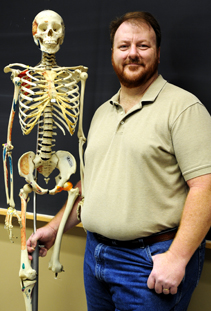 CONWAY, Ark. (December 8, 2010) – From studying theology at an evangelical college to teaching evolutionary biology at Hendrix, Dr. George Harper has made an about-face turn toward his first love – science.
CONWAY, Ark. (December 8, 2010) – From studying theology at an evangelical college to teaching evolutionary biology at Hendrix, Dr. George Harper has made an about-face turn toward his first love – science.
“A 180° would probably be about right,” he said, modestly.
Harper arrived at Hendrix in January 2007 as a visiting professor for the spring semester, but within a week, he was interviewing for a full-time teaching position.
It was “a really odd dynamic,” he said, adding that faculty in the department gave no indication whether or not they were interested in him on a long-term basis. A month later, he got a call from the Provost’s assistant saying Dr. Entzminger, Dean of the College, wanted to talk.
“I knew it was either really good or really bad,” he said.
Harper was offered the job.
“I was thrilled,” he said. He is now an Assistant Professor of Biology and jointly holds the Judy and Randy Wilbourn Odyssey Professorship with two faculty colleagues.
Harper originally heard about Hendrix through two friends in graduate school at University of North Carolina at Chapel Hill – Daniel Brown, Class of 2000, and Maureen McClung, Class of 2001 – who Harper said often spoke about “how great their alma mater was … and what a cool professor Dr. Matt Moran was.”
“That kind of stuck with me,” he said.
As he was finishing his doctorate in December 2006, Harper began exploring post-doctoral fellowships when he saw an advertisement for a visiting professorship at Hendrix.
“My adviser said, ‘Where’s that?’ and I said, ‘I actually know where that is,’” he said.
Harper declined a post-doc at University of South Florida in Tampa, Fla., and he and his wife Jennifer headed for Arkansas. Jennifer now supervises a research lab at Hendrix.
“We thought long and hard about that, but hands down Arkansas was more our style,” he said.
Born in New Jersey, Harper spent his teen years in New Mexico, graduating high school in Los Alamos. From there, he enrolled at Ambassador College, which is affiliated with the fundamentalist World Wide Church of God. Harper studied two years in Big Sandy, Texas, and completed his bachelor’s degree in theology in 1987 after two years at the school's campus in Pasadena, Calif.
Following a brief stint in Colorado, the couple relocated to Jennifer’s hometown area in western New York to help out on the family’s dairy farm. Within six months, their church was “coming apart at the seams,” Harper said. Its founder, Herbert W. Armstrong, died and leadership and doctrine changed.
“What that did for me was woke me up, and I asked myself why I was doing what I was doing,” he said.
It also reawakened his interest in science.
“I always loved science, but the church wasn’t real big on science,” said Harper. “Growing up in that religion, science wasn’t an option.”
“Ever since I was a little kid, I’d go to the library and get every book on animals and read all I could,” he said. “I was totally into animals and the science of animals.”
George and Jennifer went back to college at State University of New York - Fredonia.
His original goal was to become a high school biology teacher until his first semester when a professor insisted he sit in on some local high school biology and chemistry classes.
“One winter break of that, I knew that wasn’t the right level for me, so I set my sights on becoming a college teacher,” he said.
“I knew that I liked teaching and mentoring,” he said, recalling how he enjoyed leading Bible studies and giving sermonettes at church. “When I paired that up with my love for science, it was pretty easy.”
He finished SUNY-Fredonia in 1999 and headed straight to Chapel Hill to work on his doctorate in evolutionary biology, studying how organisms influence the evolution of one another.
At Hendrix, Harper teaches Zoology, Ecology and Evolution, and Molecular Evolution and Bioinformatics – an emerging field that utilizes genome sequences to examine evolution. He also keeps five venomous copperhead snakes in his animal research lab in the Donald W. Reynolds Center for Life Sciences. He shares the snakes with Dr. Randy Kopper, Professor of Chemistry, who studies the enzyme make-up of snake venom.
Harper has quickly embraced the culture of engaged learning at Hendrix, particularly the attention to undergraduate research.
“It is sincerely hands-on,” he said.
“I really see a different proportion of students interested in going on to grad school than I did at a place like SUNY,” he said. “Students here are passionate about research and creating new knowledge.”
Research is the best way to learn science, Harper said.
“You just get a deeper understanding more quickly through hands-on research,” he said. “They really take ownership in their learning and that really makes a difference. It’s not just ideas any more, it’s their stuff.”
While a long way from the fundamentalist roots, Hendrix is a close-knit community, like his former church, he said.
“Honestly, the people are the best part about being at Hendrix,” he said.
“It’s not one vision,” he said, comparing Hendrix to his former church. “I actually feel the drive and passion coming from the bottom up.”
Faculty, staff and students are devoted to making Hendrix a better place.
“You don’t see dead wood,” he said. “People want to work together to constantly make this place better … It’s just an exciting place.”